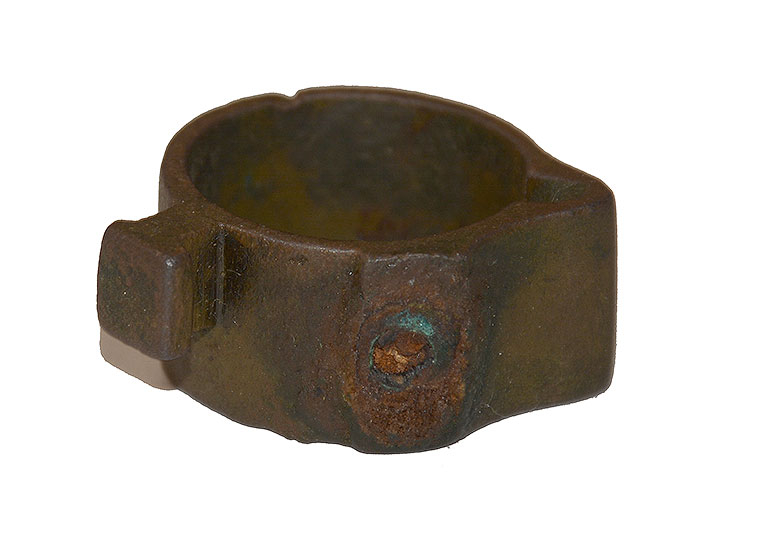site search
online catalog
RARE CONFEDERATE BOYLE, GAMBLE AND MCFEE BAYONET ADAPTER

$475.00
Quantity Available: 1
Item Code: 1000-2331
Shipping: Determined by Method & Location of buyer
To Order:
Call 717-334-0347,
Fax 717-334-5016, or E-mail
Bayonet adapters enabled rifles such as the Model 1817 and Model 1841, as well as Southern-made military rifles, to be mounted with bayonets without weakening barrels by dovetailing in studs to engage the bayonet hilts, and they could help militarize civilian rifles bored out to military caliber as well.
Boyle, Gamble and McFee made two models of adapter. Both types consisting of a solid brass band that has a bridge enabling it to slide over the front musket sight, a raised bayonet lug, and an iron screw to tighten the adapter to the musket barrel.
The first model produced by the firm was unmarked, had a square bayonet lug, and was narrower than later pieces, this particular adapter is only 0.6” wide.
This is in good excavated condition and the steel locking screw has, naturally, rusted away, but the brass body is smooth, clean metal showing a fine brown patina. Being one of the early pieces, this is unmarked.
Recovered from central Virginia. [jet][ph:L]
~~~~~~~~~~~~~~~~~~~~~~~~~~~~~~~~~~~
THIS ITEM, AS WITH ALL OTHER ITEMS AVAILABLE ON OUR WEB SITE,
MAY BE PURCHASED THROUGH OUR LAYAWAY PROGRAM.
CLICK HERE FOR OUR POLICIES AND TERMS.
THANK YOU!
Inquire About RARE CONFEDERATE BOYLE, GAMBLE AND MCFEE BAYONET ADAPTER
For inquiries, please email us at [email protected]
Most Popular
Historical Firearms Stolen From The National Civil War Museum In Harrisburg, Pa »
Theft From Gravesite Of Gen. John Reynolds »
Selection Of Unframed Prints By Don Troiani »
Fine Condition Brass Infantry Bugle Insignia »
British Imported, Confederate Used Bayonet »
Scarce New Model 1865 Sharps Still In Percussion Near Factory New »
featured item
RARE CONFEDERATE “THREE SQUARE” SOCKET BAYONET
This is an excavated example of a Confederate-made musket socket bayonet. Measuring 21” overall with a 2.75” socket. This was made for an early .69 caliber musket with a bayonet lug mounted on the bottom of the barrel; as the bridge is on the… (2022-459). Learn More »
site search
Upcoming Events
May 16 - 18: N-SSA Spring Nationals, Fort Shenandoah, Winchester, VA Learn More »





